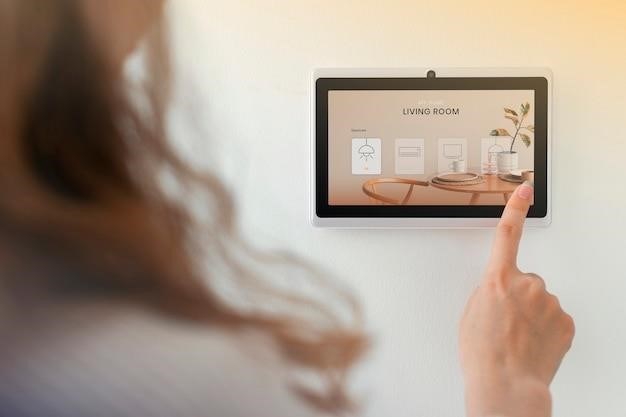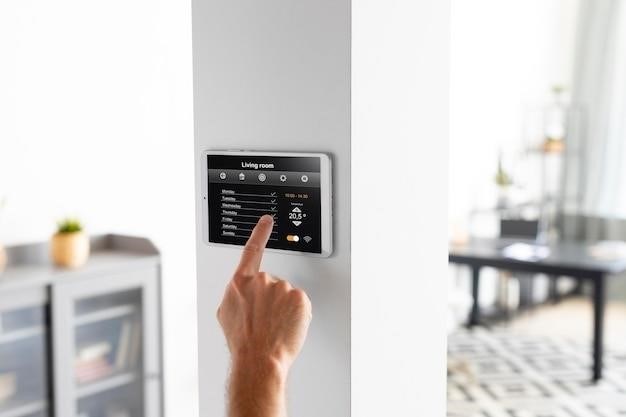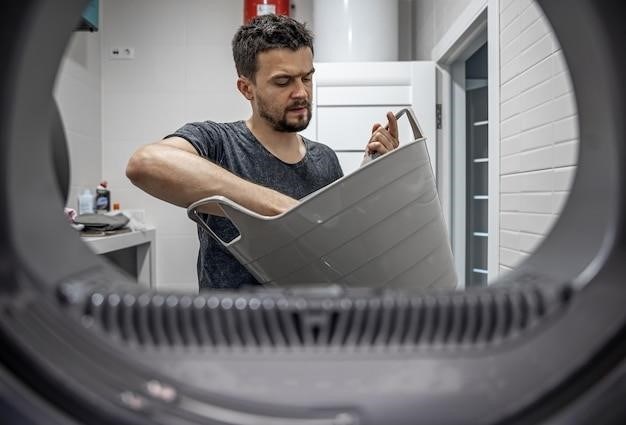PowerFlex 753 Programming Manual⁚ A Comprehensive Guide
This manual provides a comprehensive guide to programming the PowerFlex 753 AC drive, a versatile and reliable motor control solution for a wide range of industrial applications. From installation and startup to advanced programming techniques and troubleshooting tips, this manual offers a wealth of information to empower users of all skill levels. It covers essential topics such as hardware overview, software configuration, control modes and parameters, and application examples. This manual serves as a valuable resource for anyone working with the PowerFlex 753 drive, helping them to optimize performance, troubleshoot issues, and maximize the drive’s potential.

Introduction
The PowerFlex 753 AC drive is a sophisticated motor control system designed to deliver reliable and efficient performance in a wide range of industrial applications. This comprehensive programming manual serves as your guide to understanding, configuring, and operating this versatile drive. It provides a detailed overview of its features, functionality, and programming capabilities, empowering you to harness its full potential. From basic installation and startup procedures to advanced programming techniques and troubleshooting tips, this manual covers all aspects of the PowerFlex 753 drive, enabling you to optimize its performance and maximize its effectiveness in your specific applications. The manual aims to provide a clear and concise explanation of the drive’s architecture, control modes, parameters, and communication protocols. It also delves into application examples, demonstrating practical implementations of the PowerFlex 753 drive in various industrial settings. This manual is your essential companion for mastering the intricacies of the PowerFlex 753 AC drive, unlocking its full potential and achieving optimal performance in your industrial operations.
Key Features and Benefits
The PowerFlex 753 AC drive boasts an array of compelling features and benefits that make it a standout choice for diverse industrial applications. Its robust design and advanced functionality provide exceptional control, efficiency, and reliability, enhancing productivity and minimizing downtime. The drive offers a wide range of control modes, enabling precise speed, torque, and position control for various motor types. Its integrated safety features, including fault detection and protection mechanisms, ensure a secure and reliable operating environment. The PowerFlex 753 also excels in communication capabilities, seamlessly integrating with various industrial networks for seamless data exchange and control. Its user-friendly programming interface simplifies configuration and operation, allowing for quick and easy adjustments to meet changing application requirements. Moreover, the drive’s energy-efficient design minimizes energy consumption, contributing to cost savings and environmental sustainability. The PowerFlex 753’s versatility, reliability, and ease of use make it a valuable asset for any industrial operation, empowering users to optimize their processes and achieve exceptional results.
Hardware Overview
The PowerFlex 753 drive is meticulously engineered with robust hardware components that ensure reliable and efficient operation. The drive’s core is a powerful microprocessor that handles complex control algorithms and manages communication protocols. It features a high-performance inverter, capable of delivering smooth and precise control over motor speed and torque. The drive’s input and output modules are designed for flexibility and adaptability, allowing users to connect various sensors, actuators, and communication devices. The PowerFlex 753 also incorporates a robust cooling system to maintain optimal operating temperatures, ensuring long-term reliability and performance. Its compact design and modular construction facilitate ease of installation and maintenance. The drive’s hardware is carefully selected and designed to meet stringent industrial standards, ensuring durability and resistance to harsh environments. The PowerFlex 753’s comprehensive hardware components provide a solid foundation for its exceptional performance and longevity, making it a trusted choice for demanding industrial applications.
Software Configuration
The PowerFlex 753 drive’s software configuration allows users to tailor the drive’s behavior to meet specific application requirements. The drive’s software environment provides a comprehensive set of tools for configuring parameters, defining control modes, and programming custom logic. Users can access and modify the drive’s configuration through a user-friendly interface, either locally via the drive’s keypad or remotely via a network connection. The software configuration includes a variety of settings for motor parameters, control modes, communication protocols, and safety features. Users can define motor characteristics like voltage, current, and speed, select from a range of control modes such as open-loop, closed-loop, and torque control, and configure communication protocols like EtherNet/IP and RS-485. The software also allows users to implement safety features, such as overcurrent protection, overvoltage protection, and emergency stop. The PowerFlex 753’s software configuration provides a powerful and flexible platform for optimizing drive performance and tailoring it to specific application needs.
Programming Fundamentals
The PowerFlex 753 drive offers a powerful programming environment that allows users to implement custom logic and control algorithms to meet specific application requirements. The drive’s programming language is based on a structured text format that resembles common programming languages like C or Pascal. This language provides a wide range of functions and operators for manipulating data, controlling motor behavior, and interacting with external devices. Users can create custom programs to implement complex control strategies, automate sequences, and optimize drive performance. The drive’s programming environment includes a built-in editor for creating and editing programs, a debugger for identifying and correcting errors, and a simulator for testing programs before deploying them to the drive. The PowerFlex 753’s programming capabilities allow users to develop sophisticated control solutions that address the unique demands of their applications.

Control Modes and Parameters
The PowerFlex 753 drive offers a wide range of control modes to optimize performance and adapt to various application requirements. These modes include⁚
- Open-Loop Control⁚ This mode utilizes a simple voltage/frequency relationship to control the motor speed. It’s suitable for applications where precise speed control isn’t critical, such as conveyors or pumps.
- Closed-Loop Control⁚ This mode uses feedback from a sensor (typically a tachometer) to measure the actual motor speed and compare it to the desired speed. The drive then adjusts the output voltage and frequency to maintain the desired speed. This mode provides precise speed control and is ideal for applications that require high accuracy, such as machine tools or robotics.
- Torque Control⁚ This mode allows users to control the motor’s torque output, which is critical for applications requiring consistent force or load handling, like extruders or winches.
- Position Control⁚ This mode, often used in conjunction with a feedback device like an encoder, allows for precise control of the motor’s position. It’s essential for applications that require accurate positioning, such as servo drives or robotic arms.
The PowerFlex 753 drive offers a vast array of configurable parameters to tailor the drive’s behavior to specific application needs. These parameters include settings for speed, torque, acceleration, deceleration, and other critical aspects of motor control. Users can adjust these parameters to optimize the drive’s performance and achieve desired results. The drive’s comprehensive parameter set provides flexibility and control over a wide range of motor characteristics, making it suitable for diverse industrial applications.
Troubleshooting and Diagnostics
The PowerFlex 753 drive incorporates powerful troubleshooting and diagnostic features to help identify and resolve issues quickly and efficiently. These features are designed to minimize downtime and streamline the repair process.
The drive’s built-in fault detection system constantly monitors key parameters and operational conditions. When a fault is detected, the drive triggers an alarm, providing users with a clear indication of the problem. The alarm messages, displayed on the drive’s interface or through external communication protocols, provide specific details about the fault, helping users quickly pinpoint the root cause.
The PowerFlex 753 drive offers a comprehensive set of diagnostic tools to assist users in troubleshooting. These tools include⁚
- Fault History Log⁚ This log records past faults and their timestamps, allowing users to track the occurrence of recurring issues and identify potential trends.
- Parameter Monitoring⁚ Users can monitor key parameters like speed, torque, current, and voltage in real-time, providing valuable insights into the drive’s operational status and helping to identify potential problems.
- Trend Logging⁚ This feature allows users to record data over time, providing a detailed history of the drive’s performance and aiding in the analysis of long-term trends or performance changes.
- Communication Protocols⁚ The PowerFlex 753 supports various communication protocols, enabling users to remotely monitor the drive’s status, access diagnostic information, and even configure parameters from a remote location.
These diagnostic features empower users to proactively identify and address potential problems, minimizing downtime and ensuring the smooth operation of the drive. The drive’s robust troubleshooting and diagnostic capabilities contribute to its overall reliability and user-friendliness, making it a valuable asset in demanding industrial environments.
Application Examples
The PowerFlex 753 drive’s versatility and robust features make it suitable for a wide range of industrial applications. Its ability to control speed, torque, and position with precision and reliability makes it a valuable tool for various processes, including⁚
- Material Handling⁚ PowerFlex 753 drives are ideal for controlling conveyors, robotic arms, and other material handling equipment. They can optimize the speed and movement of materials, ensuring efficient and safe transport.
- Packaging and Processing⁚ In packaging lines, PowerFlex 753 drives can precisely control the speed and position of packaging machines, ensuring accurate product placement and consistent packaging quality. They also play a crucial role in food processing, controlling conveyors, mixers, and other equipment.
- Machine Tool Applications⁚ PowerFlex 753 drives can be used to control machine tools, such as lathes, mills, and grinders, ensuring precise speed and torque control for accurate machining operations.
- Pump and Fan Applications⁚ PowerFlex 753 drives are ideal for controlling pumps and fans, optimizing their performance and energy efficiency. They can adjust the speed of these devices based on demand, reducing energy consumption and extending equipment life.
- Textile and Paper Industries⁚ In textile and paper manufacturing, PowerFlex 753 drives can precisely control the speed and tension of winding and unwinding processes, ensuring consistent product quality and reducing waste.
Beyond these examples, PowerFlex 753 drives find application in countless other industries, including automotive, aerospace, pharmaceuticals, and more. Their versatility and reliability make them essential components in modern industrial automation systems.
Safety and Compliance
Safety is paramount in any industrial environment, and the PowerFlex 753 drive is designed with robust safety features to protect personnel and equipment. The drive complies with a wide range of international safety standards, ensuring its safe operation in various industrial settings.
Key safety features of the PowerFlex 753 drive include⁚
- Fault Detection and Protection⁚ The drive continuously monitors its operation for potential faults and initiates protective measures to prevent damage or injury. This includes overcurrent, overvoltage, and undervoltage protection, as well as thermal overload protection.
- Safe Torque Off (STO)⁚ This safety function deactivates the drive’s output torque, bringing the motor to a safe stop in case of an emergency. STO is critical in applications where uncontrolled motor movement could pose a hazard.
- Safe Limited Speed (SLS)⁚ SLS limits the motor’s speed to a safe level in case of an emergency. This prevents uncontrolled acceleration and potential hazards.
- Safe Stop 1 (SS1)⁚ SS1 provides a controlled and safe stop of the motor in case of an emergency. It ensures a predictable and controlled deceleration, minimizing potential hazards.
By incorporating these safety features and adhering to relevant safety standards, the PowerFlex 753 drive contributes to a safer and more reliable industrial environment.
Resources and Support
Rockwell Automation provides a comprehensive suite of resources and support to assist users in maximizing the benefits of the PowerFlex 753 drive. These resources are designed to help users at every stage of their journey, from initial setup and configuration to troubleshooting and ongoing maintenance.
Key resources and support options include⁚
- PowerFlex 753 Programming Manual⁚ This comprehensive manual serves as the primary reference guide for programming and configuring the PowerFlex 753 drive. It provides detailed information on all aspects of the drive’s functionality.
- Online Knowledge Base⁚ Rockwell Automation’s online knowledge base offers a vast library of technical articles, troubleshooting guides, and application examples related to the PowerFlex 753 drive. Users can search for specific information or browse through various categories.
- Technical Support⁚ Rockwell Automation provides dedicated technical support for users encountering issues or needing assistance with their PowerFlex 753 drives. Users can contact support via phone, email, or online chat.
- Training Courses⁚ Rockwell Automation offers a range of training courses designed to enhance users’ knowledge and skills in programming and operating the PowerFlex 753 drive. These courses cover various aspects of the drive, from basic operation to advanced programming techniques.
- Community Forums⁚ Rockwell Automation maintains online forums where users can interact with other PowerFlex 753 users, share experiences, and seek advice on various topics.
Through these resources and support options, Rockwell Automation ensures that users have the necessary information and assistance to successfully implement and maintain the PowerFlex 753 drive in their industrial applications.
The PowerFlex 753 AC drive is a powerful and versatile tool for motor control in a wide range of industrial applications. Its robust design, advanced features, and comprehensive programming capabilities make it an ideal choice for demanding environments. This manual has provided a comprehensive guide to programming the PowerFlex 753 drive, covering essential topics such as hardware overview, software configuration, control modes, and application examples.
By understanding the principles and techniques outlined in this manual, users can effectively program and operate the PowerFlex 753 drive to achieve optimal performance and efficiency. Rockwell Automation’s extensive resources and support network provide valuable assistance for users at every stage of their journey, ensuring a smooth and successful implementation of the PowerFlex 753 drive in their applications.
As industrial automation continues to evolve, the PowerFlex 753 drive remains a reliable and adaptable solution for motor control. Its ability to integrate seamlessly with other Rockwell Automation products and its commitment to industry standards make it a valuable asset for building robust and efficient automation systems. By leveraging the knowledge and resources provided in this manual, users can harness the full potential of the PowerFlex 753 drive and drive success in their industrial operations.



























